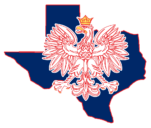Święconka ( Blessing of the Easter baskets ) will be conducted by Father Jozef Musiol, Pastor of St. Stanislaus Catholic Church in Chappell Hill on Holy Saturday, April 7, 2012 at 10 a.m. Each of you, your friends and family are encouraged to bring Easter baskets to be blessed. This Polish tradition has been adopted by many Catholic churches and continue to this day.
However, this tradition was practiced years ago in Chappell Hill and Father Jozef is gracious to help bring back this beautiful tradition. Please help us make this tradition a success by encouraging parishioners and non-parishioners from St. Stanislaus to participate celebrating one of the most enduring and beloved Polish traditions on Holy Saturday. Below is a brief article about Swieconka and the meaning behind it. I encourage you to Google “Blessing of the Easter baskets” to obtain information from other websites that may provide more detailed information on what to include in your basket.
Dziekuje!
Jim Mazurkiewicz
Święconka (Polish pronunciation: Shi-vien-zon-ka), meaning “the blessing of the Easter baskets,” is one of the most enduring and beloved Polish traditions on Holy Saturday. While originally observed by Polish Americans in the U.S., it has become increasingly mainstream in U.S and is starting to grow in the U.K. as the Polish go there to live. Catholic churches, being observed by a wide cross-section of parishes.
Baskets containing a sampling of Easter foods are brought to church to be blessed on Holy Saturday. The basket is traditionally lined with a white linen or lace napkin and decorated with sprigs of boxwood (bukszpan), the typical Easter evergreen. Poles take special pride in preparing a decorative and tasteful basket with crisp linens, occasionally embroidered for the occasion, and boxwood and ribbon woven through the handle. Observing the creativity of other parishioners is one of the special joys of the event.
While in some older or rural communities, the priest visits the home to bless the foods, the vast majority of Poles and Polish Americans visit the church on Holy Saturday, praying at the Tomb of the Lord (the fourteenth and final Station of the Cross). The Blessing of the Food is, however, a festive occasion. The three-part blessing prayers specifically address the various contents of the baskets, with special prayers for the meats, eggs, cakes and breads. The priest or deacon then sprinkles the individual baskets with holy water[3].
Modern ceremony in Poland
More traditional Polish churches uses a straw brush for aspersing the water; others use the more modern metal holy water sprinkling wand. In some parishes, the baskets are lined up on long tables; in others, parishioners process to the front of the altar carrying their baskets, as if in a Communion line. Older generations of Polish Americans, descended from early 19th century immigrants, tend to bless whole meal quantities, often brought to church halls or cafeterias in large hampers and picnic baskets.
The foods in the baskets have a symbolic meaning:
eggs – symbolize life and Christ’s resurrection
bread – symbolic of Jesus
lamb – represents Christ
salt – represents purification
horseradish – symbolic of the bitter sacrifice of Christ
ham – symbolic of great joy and abundance.
The food blessed in the church remains untouched until Sunday morning.
Photo credit: Błażej Benisz (www.wsdsac.pl)



 Jim Mazurkiewicz is a Texas native whose family originally settled in Washington County, Texas at the turn of the twentieth century. His family still owns and operates the family farm in Chappell Hill. He graduated from Waller High School and received a B.S. and Ph.D. from Texas A&M University and a Masters from Texas Tech University. Dr Jim is currently a Professor and Extension Specialist for Leadership Programs as TALL Director for Texas AgriLife Extension a member of The Texas A&M System and its statewide Agriculture Program. Jim takes great pride in his Polish heritage and plays Polish music on his concertina accordion.
Jim Mazurkiewicz is a Texas native whose family originally settled in Washington County, Texas at the turn of the twentieth century. His family still owns and operates the family farm in Chappell Hill. He graduated from Waller High School and received a B.S. and Ph.D. from Texas A&M University and a Masters from Texas Tech University. Dr Jim is currently a Professor and Extension Specialist for Leadership Programs as TALL Director for Texas AgriLife Extension a member of The Texas A&M System and its statewide Agriculture Program. Jim takes great pride in his Polish heritage and plays Polish music on his concertina accordion.